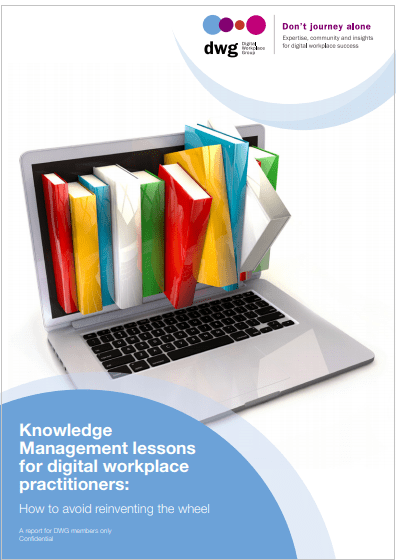What digital workplace practitioners can learn from Knowledge Management

[SYNOPSIS]: Far from being “dead”, Knowledge Management (KM) is experiencing something of a renaissance, fuelled in part by digital workplaces that are helping to deliver on some of its key tenets. For digital workplace practitioners, this presents an opportunity to learn from the successes – and failures – of KM to help them achieve their goals.
Knowledge Management (KM) is a discipline that has oscillated between excitement and obscurity, between stardom and infamy. Initially lauded as a silver bullet for a myriad of organizational challenges, it is not uncommon now to see it dismissed as a fad that (expensively) failed to deliver on its promise. Even Thomas Davenport, with whom Larry Prusak wrote a seminal book on KM in 2000, declared in 2015 that: “Knowledge Management isn’t dead, but it’s gasping for breath.”
And yet, there is enough evidence that KM is actually alive and well, and – for those organizations who are deploying their programmes effectively – a real source of competitive and organizational advantage. The Goodyear Tire & Rubber Company, for example, attributes a 50% reduction in the development cycle time of its products in part to its “Collect and Connect” KM programme.
The synergy between KM and the digital workplace
But what is KM? Great academic tracts seeking to define this seemingly elusive concept have been written. And yet, at its very heart, it’s “simply” a case of enabling people to connect to the information, people and expertise they need, when they need to, in order to support and enhance their work and the goals of the organization.
Thus, for digital workplace practitioners, there’s an oft untapped opportunity here to learn from the experiences of KMers in managing content, building communities and nurturing knowledge-sharing cultures. There is a real synergy between KM as a practice and the work of building meaningful digital workplaces, which creates an opportunity for these two areas to work hand-in-hand to build something that is greater than the sum of its parts.
DWG’s latest research report, Knowledge Management lessons for digital workplace practitioners: How to avoid reinventing the wheel, takes a look at some of the ways in which those working with the digital workplace can learn from the successes – and failures – of KMers, as they seek to better connect people with information and people with people. Here, we focus on three areas where digital workplace practitioners can work with and learn from KMers.
Identifying critical knowledge
There are two key elements in this area: proactively assessing what may be needed in the future and retrospectively reviewing what has been created in the past for its relevance.
- Identify knowledge needs: Have a credible team member work closely with your users to identify their strategic priorities and goals, and to establish what types of knowledge and information they need to help achieve those goals. You can then use this as an input for areas such as content strategy and planning, as well as community management.
- Map and review critical knowledge: Build activities into the lifecycle of a project (or indeed any type of work or process), which will create a trigger to review the content that’s been created and decide which of this content should be brought into the organization’s wider knowledge base for reuse and adaptation versus what can be archived.
Reusing information
Identifying, creating and curating knowledge and information are only useful if these resources can then be found and used by people. This is why people should be supported to seek out relevant knowledge and experience of those who have gone before them, to help them in their work.
A key way of achieving this is by embedding the finding and reuse of information into set processes, for example, on projects. During kick-off of a project, it can be useful to review lessons learned from previous relevant projects, as well as to seek out other relevant expertise and knowledge. Project and collaboration spaces within well-organized digital workplaces can make this “knowledge sweep” more efficient and effective.
Building Communities of Practice
The concept of Communities of Practice has a long-standing history within KM, existing independently of any technology choices. This is because, at their heart, communities are about connecting people with a common interest and/or expertise to enable them to share and build on that knowledge together. This can take place equally well face to face as within a digital environment.
What the digital workplace affords though is the ability to connect those people over time and space. Members of a community can connect via a video call, an online group, a project space or even a shared document that can be collaboratively edited. What shouldn’t be lost in this increased capability is the best practice of how to build a successful community. And this is something KM is able to assist with.
Some key lessons from KM are:
- Think beyond the specific online platform the community is using and keep in mind that they exist as a group of people for whom different tools are available via the digital workplace.
- The community members must have some sort of shared focus. This might be that they’re all practitioners from the same discipline, that they’re all working on the same project, or are all interested in the same specific topic.
- The reason for the community’s existence must be clearly articulated and understood. What is it seeking to achieve? What does “success” look like for it?
- The community must have visible and active leadership, which helps give it credibility, “permission” for members to participate, role-model behaviours, and can advocate for the community across the organization.
The research report also looks at areas such as curating and categorizing information, expertise finding and creating knowledge cultures, and features in-depth exclusive case studies from Microsoft Services and EY.
And so, if your organization has a KM function, get that coffee with your colleagues in the diary and see if you can collaborate to start intertwining knowledge with your digital workplace. Because, why start from scratch, if you can start from substance?
Get access to the full report and 70+ other best practice digital workplace reports
DWG members have access to this full report, which forms part of DWG’s best practice Research Library of 70+ reports covering key areas such as strategy and governance, personalization, user experience and change management for intranets and digital workplaces.
Find out what else is in the library and new research that’s coming up. Contact us to learn how to gain access to this library via DWG membership.
Research and resources
- FREE REPORT: Digital Workplace 2030: Preparing now for the digital worlds of work to come
- PODCAST: Digital Workplace Impact – Can Knowledge Management save the world?
TAKE THE NEXT STEP
Categorised in: Research reports


